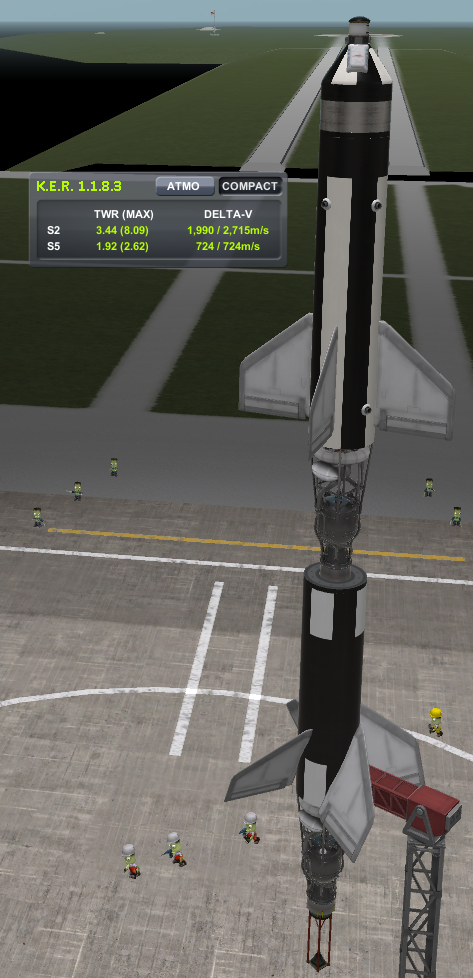Not every rocket's a winner
My initial concept for the SR-2b was to adding staging to the rocket design to be able to get more distance out of it and perform sub-orbital re-entry tests:
This design certainly fit the bill in some respects. On a good day it could achieve a height of 250km, double what we'd managed previously. Having similar fuel tanks and engines reduces the tooling cost significantly. It also had no issues around recovery of the payload vehicle (a biological sample)... when it worked.
Despite these plus points, I ran in to a major issue with the design. Notice how severely tilted the wing fins are; this was the level of spin stabilisation required to achieve the needed level of spin to keep it going straight.
Precession is a natural consequence that comes with spin stabilisation. If the spinning of the rocket is too strong, a large degree of precession occurs. Precession is best demonstrated with a spinning-top example:
 |
| Source: http://hyperphysics.phy-astr.gsu.edu/hbase/top.html |
As our level of spin increases, our rocket begins to precess like a spinning top and eventually starts to move in a circle so wide that it can no longer be considered to be pointing upwards. At this point our rocket is no longer remotely aerodynamic, nor are we thrusting upwards, and thus the rocket either spins out of control or simply fails to gain the necessary height. Here's an example with an alternate design I scrapped:
Our design can be made to be functional by carefully calibrating the level of spin, but this requires up to have a very specific set of parameters: the size of our first stage, the size of our second stage, the size of our payload, and the degree of spin can no longer be subject to change without lots of re-calibration. We have to make a lot of compromises to meet this criteria. Since I want the SR-2 design to be flexible and build upon it, this isn't desirable.
We can resolve this issue by rejecting spin stabilisation as our sole approach to stabilisation. Since, as I mentioned in the previous post, we lack reaction wheels or gimballed engines, our options are limited.
One alternative is to install an avionics system in our rocket and use the wing surfaces on our fins to keep our rocket pointing upwards, like an upwards-flying aeroplane. However, in RP-1 in 1951 this avionics technology is both expensive and massive. Since we are already on a tight budget, spending a lot on tooling a complex and heavy avionics suite we'll inevitably replace seems like a poor idea. In addition, it brings the weight of the rocket above what our launch pad is capable of handling. Our limit is 20 tonnes, but the SR-2b design concept is 25 tonnes. Upgrading our launch pad costs around 75k funds, which we simply do not have anything close to at the moment.
Looking at the design, I'm inclined to instead go back to the drawing board and try putting an SR-1 second stage of top of an SR-2 first stage. Since an SR-1 second stage would be smaller, even if avionics were required to control it, they would be much cheaper since the cost is relative to the amount of mass being controlled (in RP-1 logic, which seems a little anachronistic to me). Even without avionics it ought to be easier to manage spin due to its lower mass; it may even be possible to use reaction control thrusters at high altitudes to keep it stable. Hopefully with this we can get the pushing power of the original SR-2 design off the pad, while exploiting the SR-1's controlability and light mass, getting the best of both designs.
Next Post: Iterative Improvement



Comments
Post a Comment